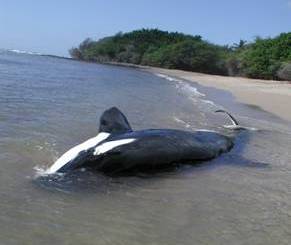Difference between revisions of "Pollution and marine mammals"
(New page: c) |
|||
| Line 1: | Line 1: | ||
| − | + | == Toxic substances in Sea Mammals == | |
| + | |||
| + | '''<u>Main substances in marine mammals</u>''' | ||
| + | |||
| + | [[Image:Stranded killer whale.jpg|thumb|right|300px| <div style="text-align: center;"> | ||
| + | Stranded Killer Whale © Hawaiian Islands Stranding Response Group | ||
| + | </div>]] | ||
| + | Like [[Ecotoxicology in Seabirds|sea birds]], marine mammals are in all marine ecosystems at the top (or very near the top) of the food chain. As such, they are particulary sensitive towards [[bioaccumulation|bioaccumulating]] substances. Most studied are [[organochlorine pesticides]] (like [[DDT|DDTs]]), polychlorinated biphenyls ([[PCB|PCBs]]) and [[metylmercury]]. Although marine mammals can accumulate large quantities of [[metylmercury]], they rarely display any harmful effects of the contaminant. The reason for this is that marine mammals can transform methylmercuy into less harmful inorganic mercury, which can also efficiently be detoxified by [[selenium]]. | ||
| + | |||
| + | The use of DDTs (since the 1970's) and PCBs (since 1991) has been banned in Europe. However because of their stability they are still present in marine ecosystems, even in very remote areas like Antarctica. Of course concentrations in Antarctica will be lower than those in the coastal areas where the discharges occurred.<ref> Kennish, M. J. (1996): Practical Handbook of Estuarine and Marine Pollution, CRC Press 524 pp</ref> | ||
| + | |||
| + | <u>'''Toxine related problems in Sea Mammals'''</u> | ||
| + | |||
| + | In the past decades contaminant related mass deaths have occurred in marine mammals. In Northern Europe, more then 20.000 seals have died due to seal plague in 1988. It is believed that the seal plague virus caused this damage because the resistance of the seals was lowered due to toxins: a process called [[immunodeficiency]]. Later this virus caused mass mortalities of striped dolphins in the 1990-1992 period: More than 1000 dolphins died in the Mediterranean. Again it's believed that casualties were increased due to immunodeficiency caused by contaminants like PCBs. <ref>Sinderman, C.J. 1996. Ocean Pollution: Effects on Living Resources and Humans. CRC Press, Boca Raton, FL. 275 pp</ref> | ||
| + | |||
| + | Below you can find some links to Belgian case studies on ecotoxicology in marine mammals. | ||
| + | |||
| + | == Case studies == | ||
| + | |||
| + | Case study 1:[[PCB and heavy metals in beached sperm whales | Toxin analysis in beached sperm whales ]] | ||
| + | |||
| + | Case study 2:[[pesticides in harbour porpoises | Organochlorine pesticides in harbour porpoises]] | ||
| + | |||
| + | ==References== | ||
| + | <references/> | ||
Revision as of 14:32, 8 July 2009
Toxic substances in Sea Mammals
Main substances in marine mammals
Like sea birds, marine mammals are in all marine ecosystems at the top (or very near the top) of the food chain. As such, they are particulary sensitive towards bioaccumulating substances. Most studied are organochlorine pesticides (like DDTs), polychlorinated biphenyls (PCBs) and metylmercury. Although marine mammals can accumulate large quantities of metylmercury, they rarely display any harmful effects of the contaminant. The reason for this is that marine mammals can transform methylmercuy into less harmful inorganic mercury, which can also efficiently be detoxified by selenium.
The use of DDTs (since the 1970's) and PCBs (since 1991) has been banned in Europe. However because of their stability they are still present in marine ecosystems, even in very remote areas like Antarctica. Of course concentrations in Antarctica will be lower than those in the coastal areas where the discharges occurred.[1]
Toxine related problems in Sea Mammals
In the past decades contaminant related mass deaths have occurred in marine mammals. In Northern Europe, more then 20.000 seals have died due to seal plague in 1988. It is believed that the seal plague virus caused this damage because the resistance of the seals was lowered due to toxins: a process called immunodeficiency. Later this virus caused mass mortalities of striped dolphins in the 1990-1992 period: More than 1000 dolphins died in the Mediterranean. Again it's believed that casualties were increased due to immunodeficiency caused by contaminants like PCBs. [2]
Below you can find some links to Belgian case studies on ecotoxicology in marine mammals.
Case studies
Case study 1: Toxin analysis in beached sperm whales
Case study 2: Organochlorine pesticides in harbour porpoises
